In the past few years, we have seen floods, low water, storms, and been locked down by a virus. Last year saw an infestation of Spongy Moth Caterpillars (formerly known as Gypsy Moths) resulting in the defoliation of many of our trees throughout the Islands.
As we head into summer, it is apparent that our latest plague has returned and is back in force, with massive numbers hatching out in our area, leaving us to wonder if we can stave off more damage to our trees.
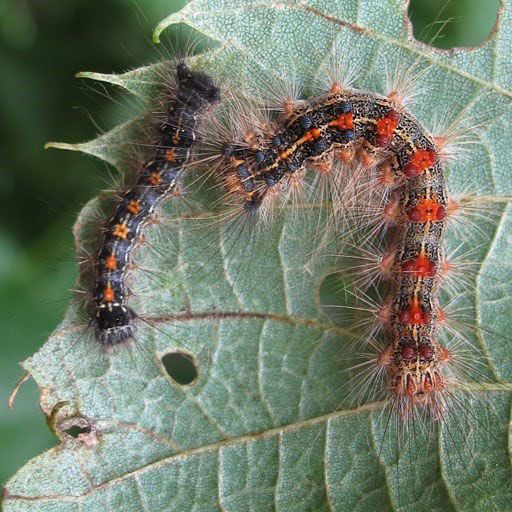
Spongy Moth History
The caterpillars formerly known as Gypsy Moth Caterpillars (Lymantria dispar dispar) were introduced to North America in 1869 in an effort to produce a hardier breed of silkworm. They first escaped into the wild in Medford, Massachusetts and have become more widespread over time.
The spread of the insect has resulted in infestations from Ontario to North Carolina, and Massachusetts to Minnesota. The invasion continues to increase with major outbreaks occurring in 10-15 year cycles, corresponding to decrease in moth predator populations, primarily small mammals.
The Spongy Moth Caterpillar’s preferred food is the White Oak, but they also attack Maple, Alder, Beech, Apple, Willow, and others. They’ll even eat pines if food becomes scarce or during heavy infestations, such as last year’s attack in southern Ontario.
Complete defoliation of large areas can occur and was seen in our area in 2021. It looks like the current outbreak will mimic last year, and more damage to trees will occur. Most healthy trees can withstand 2-3 years of leaf loss and will regrow new leaves in July, after the caterpillars have stopped feeding. Successive years of leaf loss, however, will weaken and can kill the trees. Pines that are attacked do not readily grow new needles and are more likely to be lost to heavy infestation.
Other stresses such as drought, excessive heat or moisture, and other insects can increase the possibility of tree death.
Identification
Spongy Moth Caterpillars typically hatch out of their egg masses in May, when the weather turns warmer, at the same time that young leaves begin to emerge. The insect is tiny when it emerges and remains totally black as it begins to feed.
As the caterpillars mature, they display their characteristic 5 pairs of blue dots and 6 pairs of red dots.
Look-alikes include the Eastern Tent Caterpillar, which has blue side markings and a white stipe along its length and forms communal nests, earning the “tent” name.
Another confusing specimen is the Forest Tent Caterpillar, sporting a pair of blue stripes bordering white dots that look life footprints. These also form communal nests in tree crooks and branches, something the Spongy Moth Caterpillar does not do.
Life Cycle
Spongy Moth Caterpillar infestations typically last 2-4 years and usually end due to natural forces that we will mention later.
Eggs masses are deposited on many surfaces including tree trunks and branches, as well as almost any other hard surface. The tan colored egg masses contain 600 to 700 eggs and are deposited in August, with the embryo developing in the egg in the warmth of the summer’s end. As the weather cools, the fully developed but tiny caterpillar goes into a state of suspended animation and can survive our cold winter months.
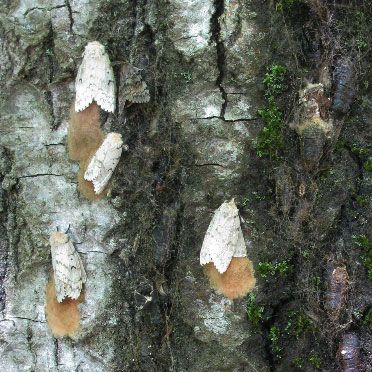
Warming weather stimulates them to chew through their egg shell and emerge in large numbers, when they begin to disperse by moving to the tree canopies. Here, through a behavior called ballooning, they hang from a silk web and are spread by the wind over an area of up to 150 yards.
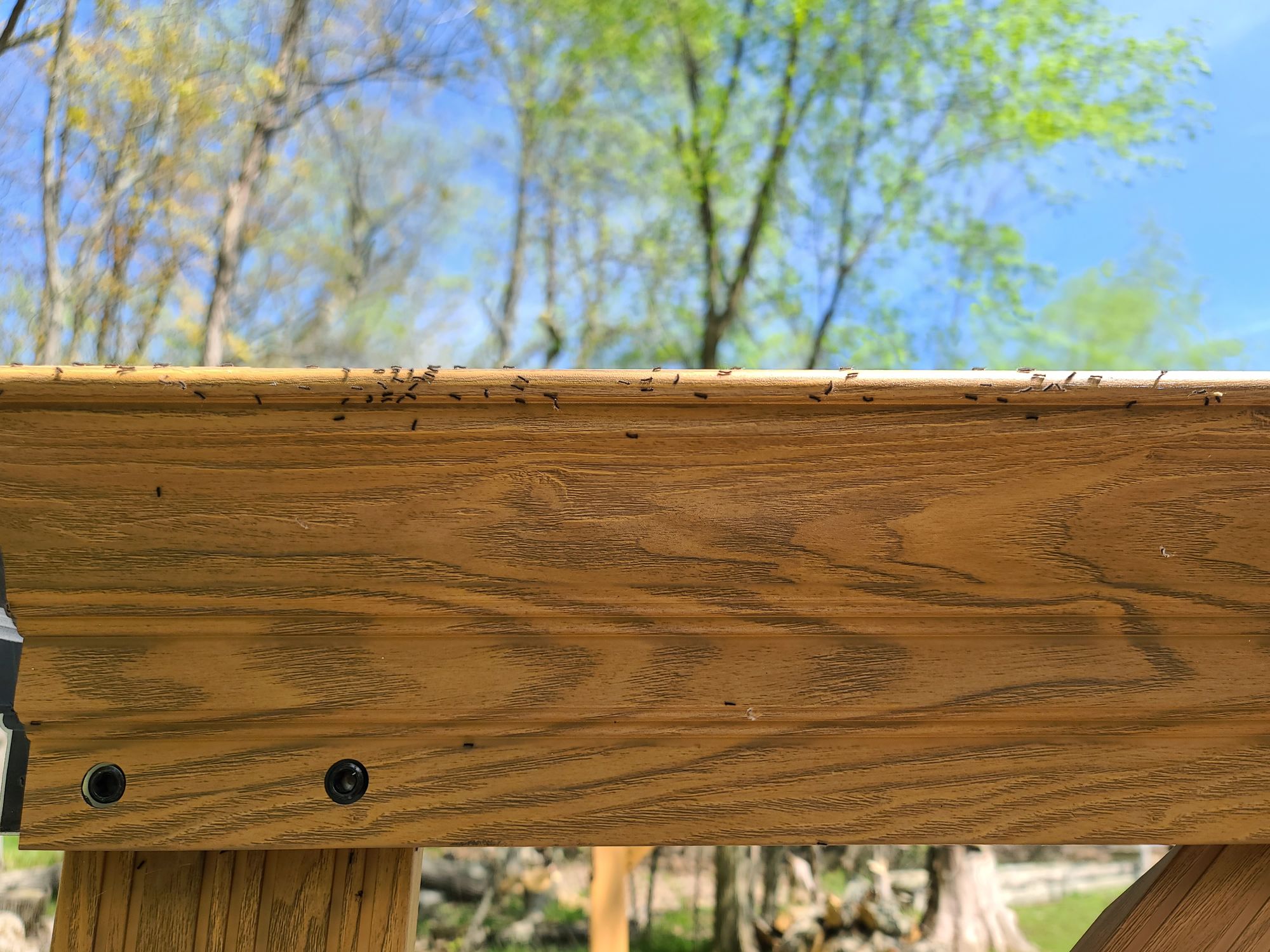
(photo of small caterpillars on Grenadier, May 14th 2022)
It is now that they become eating machines and grow rapidly, feeding at all hours until they are about an inch long.
After remaining in the tops of the trees when small, the larger caterpillars become night feeders and move down the tree in the morning to escape predators and the heat of the day. At this point, this change in their behavior presents an opportunity for control with techniques that I’ll mention later.
During the feeding phase, people often hear a sound like light rain falling and is often mistaken for the sound of the pests munching on the leaves. In actuality, it is the sound of the thousands of caterpillars defecating as they continue to mature.
Feeding continues for 5-6 weeks, with the females using the extra week to gain nourishment to support her eggs. Caterpillars molt several times during their growth phase and finally find a sheltered spot to form the hard-shelled pupa, emerging as a moth about 2 weeks later. The moth lives solely to reproduce, with the smaller male seeking out the flightless female and mating. The female then lays her eggs, beginning the cycle again.
Control Measures
Large areas of infestation defy most control measures, but some localities do offer spraying and other controls. This year, the New York State Department of Environmental Conservation (NYS DEC) has announced aerial spraying in some ecologically sensitive areas of the state but considers more widespread aerial spraying as not practical.
On our properties, it’s possible to have a positive impact using several techniques on individual trees.
Early in the life of the caterpillars, sticky traps can be made using duct tape and commercially available sticky substances, such as Tanglefoot Sticky Trap Coating. Cover the trunk of the tree with rows of duct tape and spread the sticky substance on the tape. Caterpillars moving up or down the tree will be caught in the trap and die. Replacing the trap must be done when the trap becomes full or after a heavy rain.
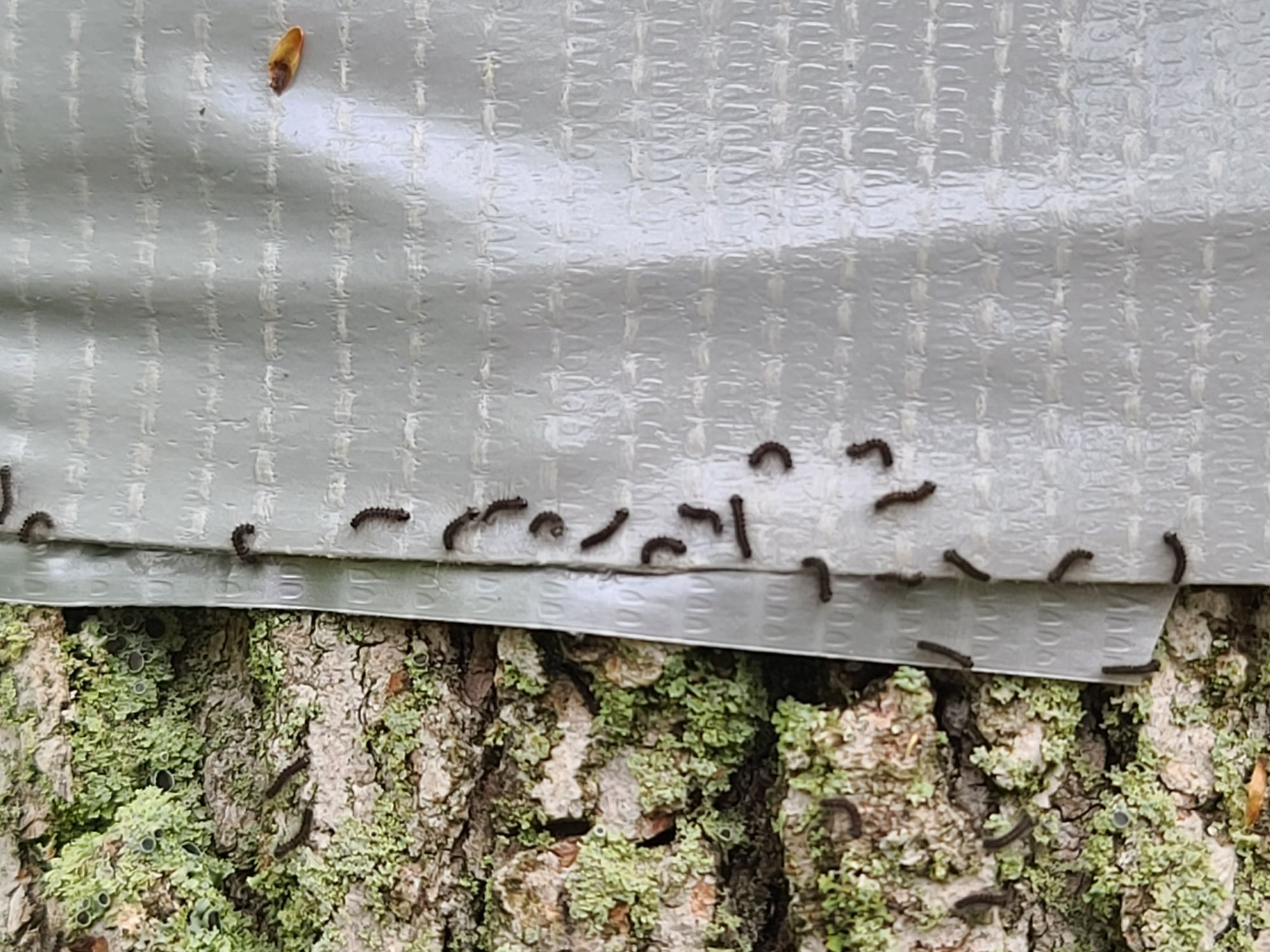
An alternative is using a duct tape trap made by wrapping duct tape around the tree completely then twisting it, so the sticky side is out, completing another row around the entire tree. This method works best when the caterpillars are small.
(photo of bugs caught on duct tape)
Once the caterpillars are larger, in early June when their behavior changes, burlap traps can be made.
This method involves wrapping a 3 to 4-foot-wide strip of burlap around the tree and tying piece of string in the middle. The top half is then folded over to create a pocket that the caterpillars naturally seek out as they try to hide from heat and predation. The trap must be checked, preferably daily and the catch removed into a bucket of soapy water and disposed of.
Wear gloves for this part because the hairs on the caterpillars may cause skin irritation in those prone to it.
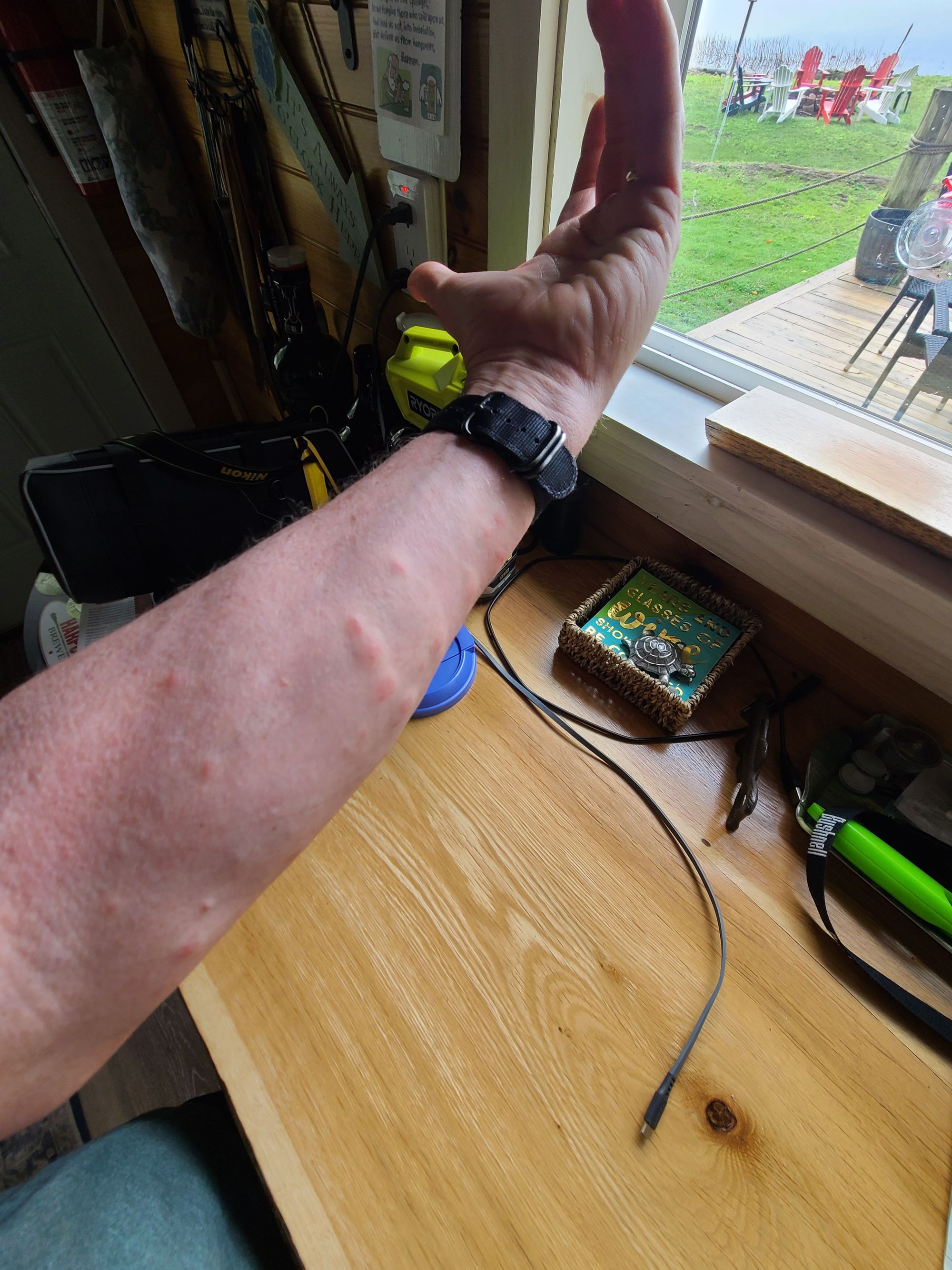
After the eggs are laid, spraying the egg masses with horticultural oil can suffocate them and reduce the next years hatch, but scraping them off trees into a bucket of soapy water is preferred. Eggs scraped onto the ground are likely to survive.
Natural control
After all we have seen with Covid, there is a virus we can actually hope spreads. Spongy Moths are susceptible to Nuclear Polyhedrosis Virus (NPV), causing the caterpillars to die of “wilt”. The dead worms are often seen hanging in a V shape and appear to be hollowed out. The carcasses of the infected caterpillars help spread the virus to others. NPV is more likely to spread in high infestation areas.
NPV is the method of control that will be used by NYS DEC in aerial spraying this year.
A naturally occurring fungus, Entomophaga maimaiga is nearly specific to Spongy Moth Caterpillars and is quite toxic to them. As with any fungus, rainy weather may be needed for this to spread. Bacillus Thuringensis is a bacterial control that can be applied to leaves, causing the caterpillars to die from infection, but is likely impractical except in spot applications.
Other non-specific chemical controls are not suggested or recommended since they can kill beneficial insects, birds, amphibians, and also can contaminate water.
References:
Excellent sources of information include:
• NYS DEC at www.dec.ny.gov/animals/83118.html,
• The Cornell Cooperative Extension
• University of Wisconsin-Madison directions for making traps can be found at Making a Burlap Barrier Band Trap – Spongy Moth (Lymantria dispar) in Wisconsin.
• How to make a duct tape band trap can be seen in this video - (2) Tree Wrapping to Mitigate Spongy Moths (Formerly Gypsy Moths)
Additional information from 2021 can be found in Thousand Islands Life June 2021 issue: Gypsy Moths by Paul Hetzler.
Help your trees by staying alert and watching for these caterpillars and keeping your trees healthy!
By Chris Piering
Chris Piering is a Doctor of Chiropractic in Syracuse with a general interest in science and nature. He is also a beekeeper. He lives in Syracuse and on Grenadier Island.
Posted in: Volume 17, Issue 6, June 2022, Nature
Please click here if you are unable to post your comment.
